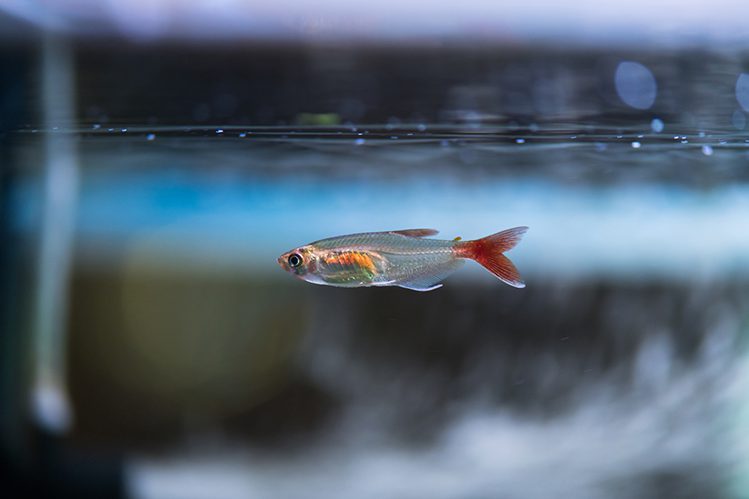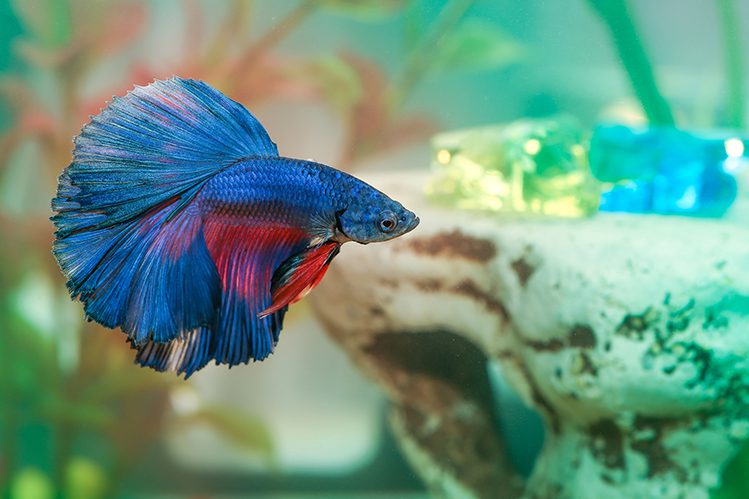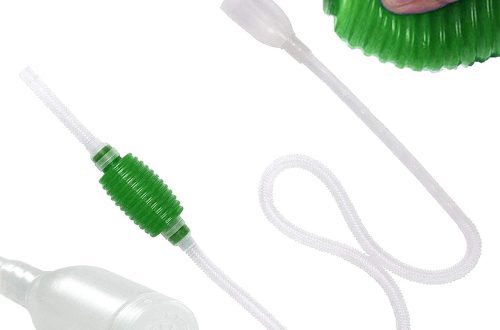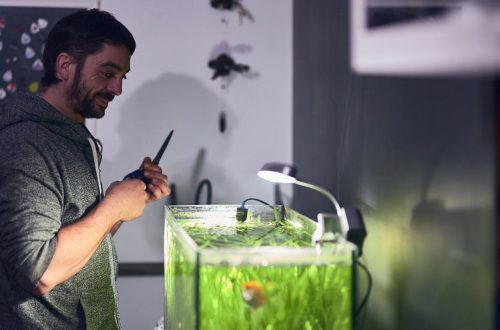
Four unpretentious exotic fish for the aquarium
Have you decided to start an aquarium, but want to fill it with unusual fish that you will not find in every second aquarium? For example, neons, guppies, zebrafish are beautiful and popular, but they are a very obvious choice for a beginner aquarist. We have collected for you information about four exotic fish that will surprise everyone with their unusual appearance and care for which even a beginner can do.
No matter how special you would like to make your aquarium, you have to start with the same thing as everyone else. That is, from the collection of information. You need to buy an aquarium, equipment for it, soil and plants when you know exactly who you are creating this aquarium for.
Write down the names of the fish that you liked. Find information about their natural habitat and aquarium conditions. What soil do they prefer? What food is right for them? What temperature and hardness, acidity of water do they need?
Study the habits of the fish you are interested in. Cichlids are aggressive, goldfish are slow and a little clumsy, and this can lead to some confusion in the aquarium. Many fish prefer to live in a flock. But even here it is necessary to observe the proportion between the representatives of the weaker and the stronger sex. African cichlids are harem fish, with two or three females per male. In barbs and danios, on the contrary, there should be more males in the flock.
On thematic resources you will find compatibility tables for fish species. The general compatibility rules are simple. If fish of different species live in the same aquarium, they must match in temperament, size, require the same temperature regime, and occupy different water layers. If all the fish in the aquarium are bottom-dwelling, someone may not have enough space.
There should be enough hiding places for the fish. Avoid overcrowding the aquarium.
- wedge belly or hatchetfish
Common wedge-belly (or hatchet fish) looks very unusual. A body flattened from the sides with a large wedge-shaped belly really resembles an ax handle. Silvery scales with dark patches resemble a polished harness with a cold metallic sheen. The structure of the body of the wedge-belly is due to its way of feeding. In nature, she catches insects and larvae from the surface of the water. It easily jumps out of the water and even flies a little. That is why at home the wedge-belly must be kept in a closed aquarium.
Moderate lighting and light flow in the aquarium will make the fish feel at home. The picture will be complemented by snags, tree leaves on the ground and plants covering the surface of the water like pistias, water lilies.
A lovely variety of this fish is the golden wedge-belly (also called the platinum wedge-belly). They are almost transparent, look very impressive in the aquarium. Wedge-bellies live in flocks. They are small but very active. In an aquarium with a volume of 150 liters or more, it is better to immediately start a company of seven to eight fish. They live from two to five years. Apistograms, neons, scalars will be good neighbors for them.
The wedge-bellies are suitable for a temperature of 26-28 degrees. Acidity 6,5-7. Hardness – up to 12. They eat specialized dry food. It is important that the feed particles stay longer on the surface of the water. It will not be able to collect the remnants of food from the bottom of the wedge-belly. In winter, you can use daphnia products. In summer, it will turn out to include small flies, mosquito larvae and so on in the diet.

- Tetras – from colorful to transparent
Tetras are very popular with aquarists, these small nimble fish are extremely interesting to watch. Among the many varieties, everyone will find unusual fish to their taste.
Tetra von rio fish is bright and unpretentious, but does not live long – three to four years. Grows up to about four centimeters in length. The tummy, pectoral and adipose fin are light. The rest of the fins and the back of the body of the fish are bright red. These peaceful fish in the aquarium will make a good company with copper tetras.
It is recommended to settle fish in flocks of seven to eight individuals in an aquarium with a volume of 50-60 liters. Tetras fon rio are suitable for water temperatures from 21 to 27 degrees. Acidity is from 5 to 7, and hardness is not more than 15. Good filtration is needed. In nature, von Rio tetras eat insects, and in the aquarium they willingly consume both live and dry food. Tetras need food with small particles. The mouth of these fish is very small.
The glass tetra is an amazing transparent or almost transparent fish of a pale blue color with a fiery red tail. It grows up to six centimeters in length. A flock of six to eight individuals can be placed in an aquarium with a volume of 60 liters or more. They like to stay in the upper layer of water. As neighbors for glass tetras, one can advise rhodostomus and neon, catfish corridors, apistograms and even larger scalars.
Transparent fish with a bright tail are suitable for a water temperature of 23-27 degrees, an acidity of 6-7,5. Rigidity – about two.
Glass tetras love live food, but they also eat high-quality specialized dry food with pleasure. Tetras will be most comfortable surrounded by floating plants and driftwood. The soil can be decorated with beech leaves.

- Cockerels – fighting fish
Cockerel aquarium fish have large multi-colored veil tails and fins. They were called fighters for a reason. They are characterized by intraspecific aggression and territoriality. The meeting of two males in the same aquarium will inevitably lead to conflicts up to a deadly fight. If you have an aquarium with a volume of 10 to 50 liters, there will be room for only one male.
Small, slow and veiled fish will be bad neighbors for bettas. If someone is hooked to a cockerel, then nimble fish like danios, tetras, catfish corridors are better suited. However, it must be borne in mind that many fish, on the contrary, can harm bettas. Even seemingly harmless neons or guppies will be happy to pat the luxurious cockerel’s tail at the right opportunity. These fish are best settled alone if you have a small aquarium. Or, if the size of the aquarium allows, create all kinds of shelters where the cockerel will hide.
How long does a cockerel fish live? These beauties are not long-livers. With proper care, their age is about three years.
The most common color of fish is inky with a reddish tint. Males are more brightly colored than females, their fins are longer. Color can be two-color, multi-color or monochrome. There are over a dozen varieties of fighting fish, and they can be distinguished by the shape and size of their fins. Poster fighting fish have relatively modest fins, while crown-tailed fins and tails look like three mohawks.
Filtration and aeration will keep the aquarium clean, create a healthy bio-balance and prevent poisonous nitrogenous compounds from accumulating in the tank. For one cockerel, a nanoaquarium is quite enough. But the larger the aquarium, the more chances you will have to correct the situation in time if the aquadom blooms or becomes cloudy.
Bettas are one of the few fish that can live without aeration. The cockerel is a labyrinth fish, it breathes both with gills and with an additional special organ (gill labyrinth), in which the blood is saturated with air.
The temperature suitable for fighting fish is 25-28 degrees. The optimal acidity of water is from 6 to 8, hardness is from 5 to 15. Driftwood, stones without sharp edges, plants (cryptocorina, hornwort) will perfectly complement the underwater world. Don’t make the lighting too bright. Leave about 10 centimeters of space between the water surface and the aquarium lid. So the cockerel will be able to come up and breathe, and the air will be warm enough for him. The fighting fish is unpretentious in food, but prone to overeating. Both live food like brine shrimp and specialized dry food are suitable for them.

- Angel fish or angelfish
Exquisite angelfish resemble triangular mother-of-pearl plates that slowly and smoothly, and sometimes with slight jerks, move around the aquarium. The shape of the body is compressed disc-shaped, large dorsal and anal fins increase in length towards the back, the ventral fins are elongated into two rays.
Scalars have a developed intellect. As neighbors, amanda tetras, swordtails, catfish corridors and other peaceful fish are suitable for them.
How many angelfish should be placed in one aquarium? They live in flocks of five individuals. But they take up a lot of space due to large fins. An adult angelfish may well reach 25 centimeters in height. Therefore, such a company will need a high aquarium with a volume of 200 liters or more. In a flock of angelfish, a hierarchy will quickly be determined, the fish will be divided into dominant pairs and pairs of the second plan. Angelfish are characterized by intraspecific aggression, so it is especially important that the aquarium is spacious and that care for the fish is thorough.
The common angelfish is the most common type of angelfish, which does not detract from its irresistibility. Dark vertical stripes adorn the light mother-of-pearl scales.
The marble angelfish is a curious variety of the common angelfish, it is slightly smaller in size. The black and white brilliant color does not go in stripes, but in spots, as if we have a piece of marble in front of us. There are no two fish with the same marbled color, there may be spots of gold and green on the back and head. And on the tail they have white dots that resemble a scattering of small pearls.
Angelfish are suitable for clear water with good filtration and dense vegetation with long stems and broad leaves. Angelfish don’t need hiding places, but they do need darker parts of the aquarium. Don’t overdo the lighting.
The water temperature is suitable for scalars from 24 to 30 degrees. Acidity is from 6 to 8, water hardness is from 5 to 13. Both live food and special dry food are suitable for them as food.

Whatever fish you choose, remember that the unpretentiousness of the fish is a relative concept. Any pet will feel best in conditions that are close to natural. And he expects you to help make his life comfortable.
We wish health to the beautiful inhabitants of your aquarium!





